 It is simply a great pleasure to step into a class of some eighty highly motivated students: when I asked who planned to start a company one day, at least half of them raised their hands!
It is simply a great pleasure to step into a class of some eighty highly motivated students: when I asked who planned to start a company one day, at least half of them raised their hands!
The name of the course for which I was a guest speaker is “Leadership and Networking,” taught by Bob Lowry. One of the books that they are currently discussing in the course is the 1936 bestseller by Dale Carnegie (no relation with Andrew Carnegie): How to Win Friends & Influence People. Although it was published more than seventy years ago, this book remains a must read – and given that it still inspires modern authors focusing on both leadership and influence, it’s never a waste of time to leaf through pages that were groundbreaking at the time.
The theme of my speech was that starting a company is a lot about “winning people to your way of thinking.” To do that, you certainly have to think about all the rules that enable you to influence people, and in particular, you have to learn how to tell your story – and tell it to an ever-expanding audience. As you analyze your product idea, position your project competitively, define its features, you always end up addressing people. Because companies and products are created by people for people.
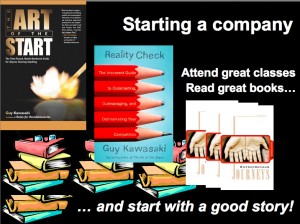 Where do you start? Read good books. The Art of the Start and Reality Check by Guy Kawasaki are the best ones. I also like Sramana Mitra’s series, Entrepreneur Journeys, because they provide portraits of entrepreneurs. Then, create your own story. Feel it. Live it. Discuss your project with those who are the closest to you, generally your family – because more often than not, they are the most likely to give you a frank opinion and support your efforts. If you want to create a five-wheel car, they won’t feel obligated to tell you politely that it’s “interesting.” Although it is possible that what you want to do is well above their head or their domain of interest or expertise, they will ask you the first hard questions (What’s the use of it? How come nobody had this idea before? Are you sure that people want this kind of stuff?). You have to recount a compelling story on why you, of all people, would be able to do something that nobody does or cannot do as well as you think you can.
Where do you start? Read good books. The Art of the Start and Reality Check by Guy Kawasaki are the best ones. I also like Sramana Mitra’s series, Entrepreneur Journeys, because they provide portraits of entrepreneurs. Then, create your own story. Feel it. Live it. Discuss your project with those who are the closest to you, generally your family – because more often than not, they are the most likely to give you a frank opinion and support your efforts. If you want to create a five-wheel car, they won’t feel obligated to tell you politely that it’s “interesting.” Although it is possible that what you want to do is well above their head or their domain of interest or expertise, they will ask you the first hard questions (What’s the use of it? How come nobody had this idea before? Are you sure that people want this kind of stuff?). You have to recount a compelling story on why you, of all people, would be able to do something that nobody does or cannot do as well as you think you can.
 The skepticism of people you trust may very well infuriate you, but will force you to hone your arguments – and if the topic is difficult, to express your hyper-sophisticated system in layman terms. This is not silly at all. Think of it this way: If you go public one day, you will have to offer a plain story to thousands of John Doe’s so that they buy your stocks. Incidentally, it’s also only if they have an idea of what you are talking about that your family will bear with the fact that you will work around the clock, take no vacation, live on a shoestring, etc.! One of the students, Tia, wondered if becoming an entrepreneur was putting a strain on personal relationships. To which I responded that it often does and that entrepreneurs have to be aware of it. To make good, though, I also added that personal relationships that collapse because of this, would most likely collapse anyway!
The skepticism of people you trust may very well infuriate you, but will force you to hone your arguments – and if the topic is difficult, to express your hyper-sophisticated system in layman terms. This is not silly at all. Think of it this way: If you go public one day, you will have to offer a plain story to thousands of John Doe’s so that they buy your stocks. Incidentally, it’s also only if they have an idea of what you are talking about that your family will bear with the fact that you will work around the clock, take no vacation, live on a shoestring, etc.! One of the students, Tia, wondered if becoming an entrepreneur was putting a strain on personal relationships. To which I responded that it often does and that entrepreneurs have to be aware of it. To make good, though, I also added that personal relationships that collapse because of this, would most likely collapse anyway!
So, you have to position your story for your immediate environment. Then, you must extend your circle as you look for co-founders and early employees. Your story is again put to the test. They may ask you about the company’s roadmap and product delivery timeline. Then comes the circle of mentors and advisors, who may have (or preferably have) a prior experience in the domain that you try to tackle, and ultimately early adopters who really know what they need and will buy your concepts only it these serve a business they ultimately know better than you do. As you expand your audience and reach for people who are not waiting for you as a Messiah, your story has to become increasingly compelling, and your beliefs must turn into measurable results. Ultimately, the extensibility of your story and of your influence show whether or not you have a real business.
Some students in the room already have the idea for a business. One of them, Derek, sells Tshirts. “Why should I buy one?” I asked as uncharitably as I could. He hesitated a few seconds, but came up with a reasonably good response.
The class is led by a real entrepreneur, a UMass alumnus, Bob Lowry. After college he didn’t know what to do and worked at various odd jobs until one day he spotted a “for rent” sign in the window of a place next door to a popular pizzeria in Amherst. He thought that a burrito shop would appeal to students, convinced his dad to invest $20,000, and four months later his first restaurant, Bueno Y Sano, was up and running. I tried the one he later opened in Northampton. I recommend it. I ordered a chicken quesadilla. Exactly what I expected. Simple, healthy and good ingredients – and a remarkable turnout at 3:30 PM! When he had his students’ average age (21), Bob had no idea of what he would do – if he would even be an entrepreneur. It’s the same for me (I was translating John Locke’s early works into French!). So when one of the students asked me how she could find a business idea, I simply responded that ideas usually come unexpectedly to people who are open minded. The important thing is to follow one’s passion and work hard.
Thanks to this wonderful class and to Bob! Just tweet a little bit more (congrats to @genuinejack)…
Marylene Delbourg-Delphis
For more information about Dale Carnegie: http://en.wikipedia.org/wiki/Dale_Carnegie and http://en.wikipedia.org/wiki/How_to_Win_Friends_and_Influence_People
For more information about Bob Lowry and Bueno y sano http://www.buenoysano.com/aboutbys.html
Tags:Bob Lowry·Bueno y Sano·Dale Carnegie·Entrepreneur·Entrepreneur Journeys·Guy Kawasaki·How to Influence People·Leadership·Networking·Positioning·Reality Check·Sramana Mitra·Storytelling·The Art of the Start·UMass Amherst
Entrepreneurial tourism… It is definitely worth flying to Detroit to spend one or two days at The Henry Ford Museum and Greenfield Village in Dearborn. It is the largest estate dedicated to the history of American lifestyles and technology innovations – and it also includes a high school! Originally called the Edison Institute of Technology and Greenfield Village (celebrating 50 years of the electric light in 1929), the organization spun off from the Ford Motor Company after the death of Henry Ford in 1947. It is a Non-for-Profit-Organization efficiently managed as a one-of-a-kind intellectual “resort” (also offering great food) by Patricia Mooradian.
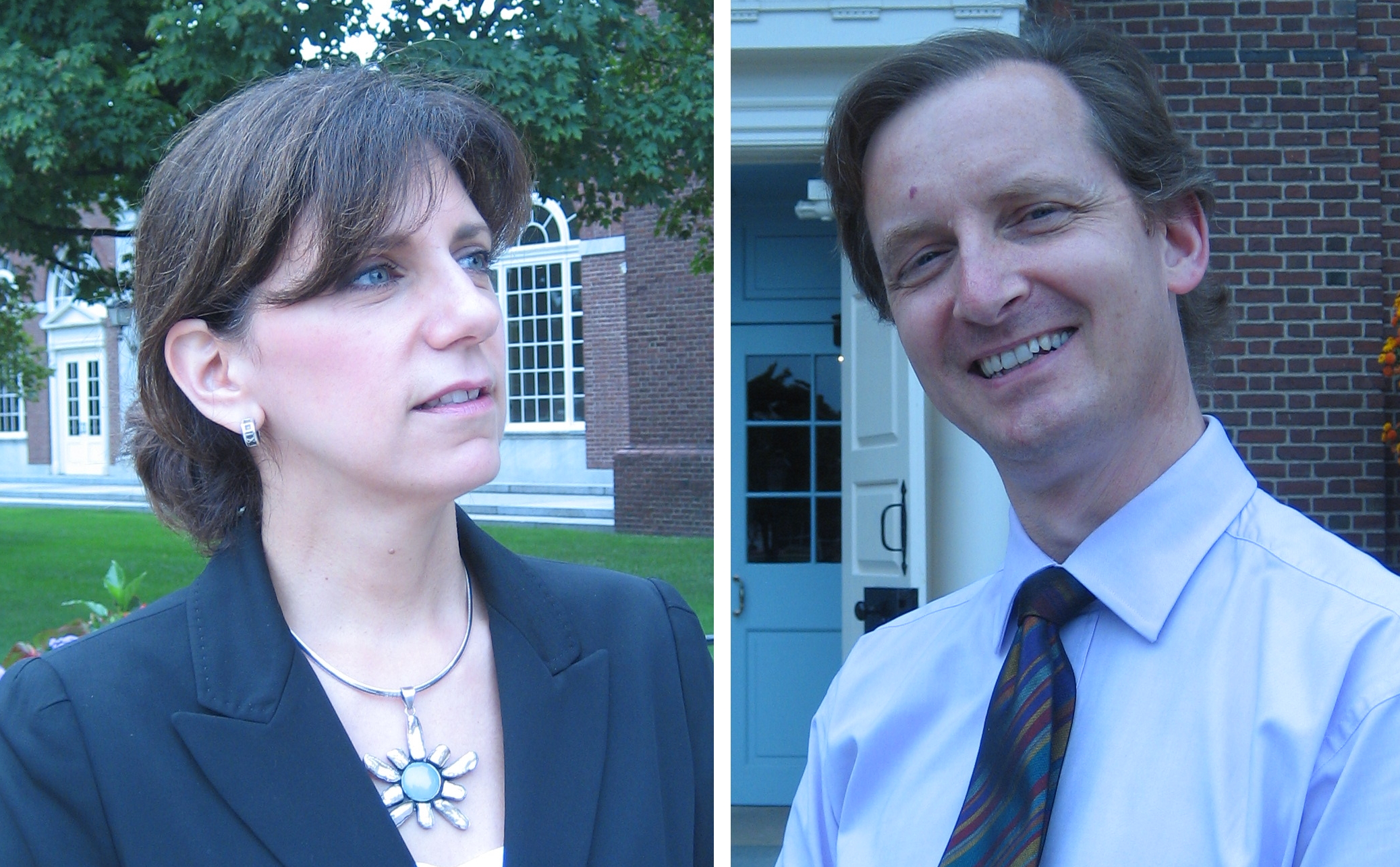
Patricia Mooradian (left); Marc Greuther (right)
I was lucky enough to walk through part of the Museum with Patricia and Marc Greuther, the Curator of Industry and Design (he simply knows everything!). Every step of the way, I was thinking that the only “entrepreneurial tourism” most entrepreneurs really know only takes them to a limited number of hot spots, such as Silicon Valley or Boston, and this mostly for practical purposes. Yet, there are many more places able to give aspiring entrepreneurs the opportunity to think about what entrepreneurship and innovation are about, reflect over the lives of some predecessors, even when they may not be directly related to their field. The Henry Ford Museum is definitely such a place — and would be a great alternative to most of the impersonal resorts that host high-tech conferences. Where else can you see dozens of authentic structures such as the home of Noah Webster, who wrote the first American dictionary, or Thomas Edison’s lab in Menlo Park (NJ)?
A non-linear history of innovation… Most entrepreneurs want to be innovators, i.e. produce value by making a meaningful difference in the lives of people. Where do they start? Do they wake up one day with the idea of the century with “Eureka!” on their lips? No. Most innovations start in silence and actually reach their epiphanic status at the end of a frequently complicated road, and after the ups and downs of trials and errors. One of the big plusses of The Henry Ford is that it features the non-linear history of innovation remarkably. Henry Ford literally stockpiled things he loved, and the beauty of the Museum is that curators over time did not try to impose the artificial logic of chronology. I love the fact that the oldest surviving steam engine in the world (created in the early eighteenth century by Thomas Newcomen to pump water out of a deep mine in England) is simply yards away from a 1931 Bugatti Royale — and that nobody in charge of this fabulous venue tried to reduce the exuberance of innovation along a simplistic time-line of progress. The important thing here is that both “engines” were part of Ford’s personal world. He had operated the Westinghouse portable steam engine at his parents’ farm and was later hired by the Westinghouse company to service their steam engines.
 Disruptiveness is a group phenomenon, lest it’s art… Created by Henry Ford at the peak of his success, the museum is a tribute to Thomas Edison — whom the young Ford idolized. For Henry Ford, working in 1891 as an engineer with the Edison Illuminating Company was as extraordinary as being hired at Apple is for a programmer. Just imagine the pride of the young man as he was introduced to Edison at a company-sponsored convention in Manhattan Beach, New York in 1896 “as a young fellow who has made a gas car.” At the age of 32, Ford had created this first car, the Ford Quadricycle, which he sold for $200 in 1896 to a Detroit resident, Charles Ainsley (and bought it back a few years later). Looking at the vehicle in the museum, I realized that automobile creators had to overcome people’s fascination with bicycles as much as they had to move away from the “horseless” carriage in order to actually create what we know now as a modern automobile. It was no less interesting to look at what Benz was doing at the exact same time – and know that Ford was just as harsh about this competitor on exhibition at Macy’s store in New York in 1895 as any high-tech entrepreneur today. Innovation is disruptive, that’s true, but primarily in the sense that it outdates existing patterns and concepts through an often chaotic process, and no entrepreneur should claim to be alone in such ability to disrupt thinking-as-usual. In fact, “disruptiveness” is often an after-the-fact statement by people who either don’t know or want to ignore all intermediate iterations.
Disruptiveness is a group phenomenon, lest it’s art… Created by Henry Ford at the peak of his success, the museum is a tribute to Thomas Edison — whom the young Ford idolized. For Henry Ford, working in 1891 as an engineer with the Edison Illuminating Company was as extraordinary as being hired at Apple is for a programmer. Just imagine the pride of the young man as he was introduced to Edison at a company-sponsored convention in Manhattan Beach, New York in 1896 “as a young fellow who has made a gas car.” At the age of 32, Ford had created this first car, the Ford Quadricycle, which he sold for $200 in 1896 to a Detroit resident, Charles Ainsley (and bought it back a few years later). Looking at the vehicle in the museum, I realized that automobile creators had to overcome people’s fascination with bicycles as much as they had to move away from the “horseless” carriage in order to actually create what we know now as a modern automobile. It was no less interesting to look at what Benz was doing at the exact same time – and know that Ford was just as harsh about this competitor on exhibition at Macy’s store in New York in 1895 as any high-tech entrepreneur today. Innovation is disruptive, that’s true, but primarily in the sense that it outdates existing patterns and concepts through an often chaotic process, and no entrepreneur should claim to be alone in such ability to disrupt thinking-as-usual. In fact, “disruptiveness” is often an after-the-fact statement by people who either don’t know or want to ignore all intermediate iterations.
 As you walk through the museum, you realize that innovators that meet market success come in droves at any given time in any given genre (even if some are more successful than others). Solitarily disruptive innovators often fail – and may unwittingly join the ranks of artists. One of the most magnificent disruptive dead ends of the museum is the Buckminster Fuller’s Dymaxion house – packed with revolutionary ideas, but now a piece of modern art.
As you walk through the museum, you realize that innovators that meet market success come in droves at any given time in any given genre (even if some are more successful than others). Solitarily disruptive innovators often fail – and may unwittingly join the ranks of artists. One of the most magnificent disruptive dead ends of the museum is the Buckminster Fuller’s Dymaxion house – packed with revolutionary ideas, but now a piece of modern art.
 And it all comes back to the some mythical and recurring beginning … I liked the entrance/exit of the museum. On September 27, 1928, Thomas Edison thrust a shovel once used by Luther Burbank (1849-1926), one of the most creative American botanist and horticulturist, into a freshly poured concrete block and signed his name on the site of the planned museum building (modeled after Independence Hall in Philadelphia). Speak of a syncretistic view of America – as well as a key feature of innovation, i.e. the ability to integrate artifacts in both nature and society.
And it all comes back to the some mythical and recurring beginning … I liked the entrance/exit of the museum. On September 27, 1928, Thomas Edison thrust a shovel once used by Luther Burbank (1849-1926), one of the most creative American botanist and horticulturist, into a freshly poured concrete block and signed his name on the site of the planned museum building (modeled after Independence Hall in Philadelphia). Speak of a syncretistic view of America – as well as a key feature of innovation, i.e. the ability to integrate artifacts in both nature and society.
Marylene Delbourg-Delphis
More information about the Henry Ford Museum and the Village (description & services): http://www.hfmgv.org/ and the stores: http://www.thehenryford.org/shop/index.aspx
About Patricia Mooradian: http://www.metromodemedia.com/blogs/bloggers/PatriciaMooradian0067.aspx; http://www.culturalalliancesemi.org/index.php?option=com_content&task=view&id=59&Itemid=0
About Marc Greuther: http://innovatorsroadtrip.com/2009/03/j-marc-greuther-curator-of-the-henry-ford-museum/
You may also want to take a look at Henry Ford’s autobiography: My Life and Work – An Autobiography of Henry Ford
Tags:Benz·Buckminster Fuller·Bugatti Royale·Disruptiveness·Dymaxion house·Edison Institute of Technology·Entrepreneur·Entrepreneurial tourism·Ford Motor Company·Ford Quadricycle·Henry Ford·Independence Hall·innovation·Luther Burbank·Marc Greuther·Marylene Delbourg-Delphis·Noah Webster·Patricia Mooradian·The Henry Ford Museum and Greenfield Village·Thomas Edison·Thomas Newcomen
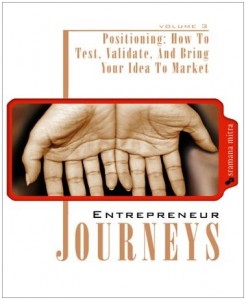 I already spoke twice about Sramana Mitra – the reality is that she writes a lot and here she is again with the third volume of Entrepreneur Journeys: Entrepreneur Journeys v.3: Positioning: How To Test, Validate, And Bring Your Idea To Market.
I already spoke twice about Sramana Mitra – the reality is that she writes a lot and here she is again with the third volume of Entrepreneur Journeys: Entrepreneur Journeys v.3: Positioning: How To Test, Validate, And Bring Your Idea To Market.
Sramana chooses four domains for this book: Going Vertical, Cloud Computing, Collaboration and Content Publishing. As usual, she illustrates each topic with case studies — more specifically, with interviews of entrepreneurs who recount how they approach their respective markets and address them adequately — responding to real expectations and trying to do it better than their competitors. What makes TheFind a more satisfactory experience than Like.com, for example? This is one of the topics that founder Siva Kumar had to think about. What are the secrets of Kosmix’s or Stardoll’s customer acquisition strategies, or of the integrated advertorial campaigns at Glam (headed by an old friend of mine, Samir Arora)?
Cloud computing under its various forms, Sofware-as-a-service (SaaS), Infrastructure-as-a-service (IaaS) or Data-as-a-service (DaaS), continues to re-architect the industry. Sramana warns her native country: “the cloud computing mega-trend plays against India’s tradition of answering all scaling problems with more bodies.” Meanwhile, Ken Rudin (LucidEra) wants to shake up the somewhat stagnant business intelligence industry. To understand a successful roll-up strategy, read the story of Mike Cordano and Keyur Patel, the co-founders of Fabrik, acquired by Hitachi, earlier this year, and to optimally operate in overcrowded or difficult spaces, take a look at Ken Plunkett’s journey at Salary.com, Jim Heeger’s value proposition at PayCycle — or, in an entirely different world (gaming), at John Welch (PlayFirst).
These entrepreneurs may come from any country: Umberto Milletti (InsideView) was born in Italy; they may have started with traditional jobs: Steve Adams (Sabrix) used to teach English and Kevin Weiss (iUniverse) spent 17 years at IBM. They can even be a VC, such as Brian Jacobs from Emergence Capital! They all like challenges and do not hesitate to take on big players as does Sharat Sharan (ON24), D.D. Ganguly (DimDim), or to venture into bourgeoning markets where others are already staking claims as Jeff Housenbold (Shutterfly). In all cases, these entrepreneurs have a passion for what they do and are comfortable answering questions related to their value proposition, their competitive positioning and pricing. They are on top of the sales cycle and messaging. They know how to qualify leads and have clear execution roadmaps.
You will enjoy reading this book and will easily relate to the entrepreneurs that Sramana interviews. When you are done, take the time to try to respond to each of the questions listed in her “Appendix: Clarify your story.” This may be a grueling exercise — but do go out there before you have real answers!
I like this book. I only regret one thing — the very small number of women entrepreneurs throughout this book series. Now wonder, though. As Chris Shipley wrote again a year ago “fewer than 10 percent of venture-based technology companies have a woman on the founding team.”(http://www.demo.com/community/?q=node/20448)
Marylene Delbourg-Delphis
My posts about the two first volumes of Entrepreneur Journeys:
http://delbourg-delphis.com/2009/05/sramana-mitra-bootstrapping-weapon-of-mass-reconstruction/
http://delbourg-delphis.com/2008/11/sramana-mitra-entrepreneur-journeys/
Tags:Brian Jacobs·Business Strategy·Chris Shipley·Cloud Computing·Content Publishing·D.D. Ganguly·Data-as-a-service (DaaS)·DimDim·Emergence Capital·Entrepreneur·Fabrik·Glam·Going Vertical·Infrastructure-as-a-service (IaaS)·InsideView·iUniverse·Jeff Housenbold·Jim Heeger·John Welch·Ken Plunkett·Ken Rudin·Kevin Weiss·Keyur Patel·Kosmix·LucidEra·Marylene Delbourg-Delphis·Mike Cordano·ON24·PayCycle·PlayFirst·Product Positioning·Sabrix·Salary.com·Samir Arora·Sharat Sharan·Shutterfly·Siva Kumar·Sofware-as-a-service (SaaS)·Sramana Mitra·Stardoll·start-up·Steve Adams·TheFind·Umberto Milletti·Women in technology
September 11th, 2009 · Book Review
 It took about ten years for Brick-and-Mortars to figure out how they could best exist within the Web 1.0. They will have far less time to understand that marketing is turning into a completely new social and linguistic genre. Erik Qualman’s book, Socialnomics: How social media transforms the way we live and do business is an effective wake-up call for corporations and marketers, and is written by a sincere and authentic practitioner.
It took about ten years for Brick-and-Mortars to figure out how they could best exist within the Web 1.0. They will have far less time to understand that marketing is turning into a completely new social and linguistic genre. Erik Qualman’s book, Socialnomics: How social media transforms the way we live and do business is an effective wake-up call for corporations and marketers, and is written by a sincere and authentic practitioner.
Amazon, Qualman reminds us, did a stellar job when it introduced the concept of affinity marketing, but as efficient as it was, it had its shortcomings, especially if buying My Little Pony for your niece was a one-time thing. Going a step further, Amazon started to showcase other books that people who bought the same book as the one you are looking at, also bought. The social media approach is a next era and shows that in the “people-driven economy,” effective affinity marketing is a contagious recommendation process operating within affinity groups. Instead of being told what people in general are interested in, we want to know what people in our network, people we appreciate, would advise based on their experience – an experience to which we tend to pay attention because we generally trust our friends. “People referring products and services via social media are the new king. It is the world’s largest referral program in history.” This is a new world that Qualman calls “the world of socialnomics.”
A few years ago, the very notion of “socialnomics” would have sounded like an odd linguistic construct, and, in the end, simply meant “management/rules of what is social,” just as economics originally designates the management/rules of a household. In many respects, the term “socionomics,” coined by Prechter in 1999, could have also been used, as it is the “study of social mood and its results in social actions.” However, through the word “socialnomics,” Qualman wants to emphasize the idea of an economy governed – I should say “mediated” — by social media as it leads to the creation of innumerable communities and tribes. This “social-media mediation” is perceived by individuals as a form of disintermediation and deliverance, shielding them from the marketing litanies imposed upon them by impersonal marketing machines. What we hear in our social media world comes from people we have chosen to listen to. The intermediaries are not mercenary message-carriers (or so we hope), they are peers of sorts and therefore, are not perceived as middlemen (even when there can be a bit of a sandwich man about them). This is why the world of “socialnomics” is not felt as yet another form of social pressure. We have the freedom to select the circles to which we belong, ensure that they mirror our needs and tastes, exchange points of views and ask questions with the hope of getting a candid response.
The eight chapters of the books analyze the new challenges and opportunities that the social media re-segmentation and restructuring of the market will present to businesses. Are customers going to reduce their reliance on the results they get from search engines? It is most likely. “I care more about what my neighbor thinks than what Google thinks,” if I want to buy a baby seat. It is also obvious that customers expect companies to converse with them in “open, two-way conversations” and that customer “services” are poised to become the customers’ voice and, consequently, a central part of marketing departments. Therefore, “businesses need to fully transform to properly address the impact and demands of social media.” And companies that fear to venture into the open, display their customers in the social media fora, will atrophy much faster than they think. Installed bases are joining the “Glass House Generation” at a fast pace, and follow its lifestyle — hang out anywhere and at all times in public view. Qualman indicates that “by 2012, eMarketer projects that more than 800 million users worldwide will participate in social networks via their mobile device, up from 82 million in 2007.” Meeting these new challenges as well as leveraging these new opportunities will definitely require new skills and new tools!
Marylene Delbourg-Delphis
More about the word “socionomics”: http://en.wikipedia.org/wiki/Socionomics
Tags:Affinity groups·Affinity marketing·Disintermediation·Erik Qualman·Glass House Generation·Middleman·Referral program·Sandwich Man·Seach engines & Social Media·Social Media & Social Pressure·Socialnomics·Socionomics·Tribes
 Each culture has its ideal cities, communities, phalanxes, religious, economic or political wonderlands as well as its Fata Morgana kingdoms. We have our own form of utopia, Twitterville. It could have been Twittertown, Twitterburg, Twitterborough or Twitterpolis. No, it’s Twitterville. Shel Israel prefers to use the French suffix ville, derived from the Latin “villa,” an estate on the outskirts of a city, with a ” homey, small-town feel.” Yet, the minute you enter the place, you find out that Twitterville is a kind of sprawling environment, “a global neighborhood” made of an infinity of the smaller neighborhoods that Twitterville citizens select to create for themselves, depending on their business or personal interests. They follow and/or are followed by other citizens from the most diverse vicinities in the comfort of their home. In a way, this Utopia is really what the word actually means: a no-place that is nowhere, but in anyone’s mind, unconstrained by geography. However, instead of emanating from a single thinker, à la Thomas Moore, it sprang out from a wave that Chris Shipley from the Guidewire Group called “social media” in 2004 [1] and “materialized” as it is by a software platform (Twitter), Twitterville is a fully crowdsourced utopia.
Each culture has its ideal cities, communities, phalanxes, religious, economic or political wonderlands as well as its Fata Morgana kingdoms. We have our own form of utopia, Twitterville. It could have been Twittertown, Twitterburg, Twitterborough or Twitterpolis. No, it’s Twitterville. Shel Israel prefers to use the French suffix ville, derived from the Latin “villa,” an estate on the outskirts of a city, with a ” homey, small-town feel.” Yet, the minute you enter the place, you find out that Twitterville is a kind of sprawling environment, “a global neighborhood” made of an infinity of the smaller neighborhoods that Twitterville citizens select to create for themselves, depending on their business or personal interests. They follow and/or are followed by other citizens from the most diverse vicinities in the comfort of their home. In a way, this Utopia is really what the word actually means: a no-place that is nowhere, but in anyone’s mind, unconstrained by geography. However, instead of emanating from a single thinker, à la Thomas Moore, it sprang out from a wave that Chris Shipley from the Guidewire Group called “social media” in 2004 [1] and “materialized” as it is by a software platform (Twitter), Twitterville is a fully crowdsourced utopia.
Shel Israel takes us through Twitterville with the fervor of a proud resident and engaged storyteller — eventually adding autobiographical details to enliven his narrative. And here we have in one breath an archeology of Twitterville, the history of its first settlers, famous people, unknown entities or businesses of all sizes, and dozens of Twitter addresses for the reader to try. He takes us though a chronicle of local adventures and mishaps as well as successful interactions between users and notoriously unfriendly providers both on earth and in the skies – and we can only wonder what U-Haul can do to recover from its repeated blunders or Motrin from the headaches that the brand created for itself. For, in Twitterville, bad rap might last just as long as they did in old-time villages. Everybody talks in the megalopolis and news, good or bad, true or false, uncontrollably propagate. Twitterville is all about conversation, i.e. any talk from babble to debate, and as a result, conversational marketing as much about reputation as it is about content.
Twitterville is not simply a marketing manual and is often really entertaining: it is a collection of stories for whomever wants to have a feel of what it is like to live in Twitterville and experience its continuously morphing precincts and innumerable downtowns. The conversational marketing manifesto side of the book comes across as summary rules and principles by which twitterers abide to be part of the community. In many respects, Twitterville is a free-style sequel to Naked Conversations: How Blogs are Changing the Way Businesses Talk with Customers, a book that Shel Israel wrote with Robert Scoble. However, while Naked Conversations discussed how to talk to people and customers through blogs, Twitterville is more about how to talk with people as you talk to them. “Spinning and targeting are outmoded,” and selling products is not the starting point of a conversation, only the symbol of an established social relationship. Basically Twitterville makes us rediscover the beautiful ambiguity and complexity of the definition of the word “commerce” which refers to 1) a “social intercourse: interchange of ideas, opinions, or sentiments”
and 2) the “exchange or buying and selling of commodities on a large scale involving transportation from place to place.”[2]
Marylene Delbourg-Delphis
[1] http://www.prnewswire.com/cgi-bin/stories.pl?ACCT=105&STORY=/www/story/07-22-2004/0002215949
[2] http://www.merriam-webster.com/dictionary/commerce
More about Shel Israel
http://www.redcouch.typepad.com/weblog/information.html
http://en.wikipedia.org/wiki/Shel_Israel
Tags:Chris Shipley·Conversational Marketing·Global Neighborhoods·Guidewire Group·Naked Conversation·Robert Scoble·Shel Israel·Social Media·Thomas Moore·Twitter·Twitterville·U-Haul·Utopia
“We invest in people…” is a phrase that entrepreneurs hear often from VCs and employees from corporations. What does it mean? Hard to know – or maybe, the actual content of the sentence depends on who is speaking.
OK, LinkedIn isn’t the whole spiel: For most people, you are your “background” and this “background” boils down to your résumé on LinkedIn. But a résumé is, by definition, limited: it is a summary. If Sergey Brin or Larry Page had sent a résumé to MSN, they would not have been asked to create the search engine of the future right away. Although they both had enrolled in the Stanford Ph.D. program, they were not “proven” yet. Who would have hired Steve Jobs, Steve Wozniak, or Bill Gates in key positions? The history of these iconic figures reminds us that what most people call “background” is only the foreground, a few degrees and a work experience that jump out to hiring managers and most investors. The end result is what we know: multitudes with “relevant” degrees and tons of “great” recommendations populate companies — small or big – and more often than not, these perfect recruits can’t make much happen beside ensuring business as usual and maintaining the status quo.
We all know that a great employee (or great entrepreneur) is more than a résumé. It’s a human being with a real background, whether you understand the word “background” as the software that is not displayed but is silently operating in the head and the heart of that person, or as the overall implicit or explicit setting or scenery in which a person places himself/herself and the vibes he/she transmits. This part is the fuzzy aspect of interviews — for better or worse, for both the interviewees and the interviewers, no matter how streamlined the interview process in a company may be or how well the interviewee has prepared. But how can people convey who they really are? And how can people know more about you? This takes me to a poll that I recently offered mostly via Twitter, Facebook, and LinkedIn.
What do you do if you are asked to bring up your Facebook page during an interview? After fumbling for a few minutes with the wording of my poll, here is what I finally offered: “A male hiring manager asks a woman to show him her Facebook page in an interview. What should she do: Agree; Refuse and see what he says; Ask why and then decide; Walk out of the interview?”
The idea of that poll came from a comment to a post by Renee Weisman, Keeping Your Online Identity Professional (http://www.womenco.com/benefits/articles/3608-keeping-your-online-identity-professional?page=1): “A friend just told me that at the interview, her hiring manager asked her to bring up her facebook page. He wanted to see the types of things she was posting as a way to judge whether she would fit in his organization!”
Over 95% of the responses came through Twitter and the majority from the United States. After the first 100 votes, I noticed that percentages changed very little. Only a little under 12% of the respondents would immediately agree to bring up their Facebook page. I received multiple personal comments ranging from the right of having a privacy to the fact that our life is so much all over the Internet already that bringing up a Facebook doesn’t make that much of a difference. The poll was anonymous, but based on direct remarks, it is clear that people in their early twenties are the most open. One said: “Anyway, what 99% of people have on their Facebook is what 99% of the rest of the population also has. We have tons of pictures. It’s well known that other folks’ pictures are downright boring. So any hiring manager may be quickly bored as he/she goes through our galleries.” Another said. “My response would be ‘sure.’ Can you bring your page too? You want to know whom you will hire, and I want to know more about who is hiring me and for whom I’ll work.”
The fact that over 50% say that they would “ask why and then decide” (they may end up agreeing for fear of losing a job opportunity in a tight job market), that over 25% would refuse and see what the hiring manager says, and that almost 8% would walk out of the interview is all the more striking as employers increasingly screen employees’ Facebook and MySpace pages: “Forty-five percent of employers reported in a recent CareerBuilder survey that they use social networking sites to research job candidates, a big jump from 22 percent last year. Another 11 percent plan to start using social networking sites for screening. More than 2,600 hiring managers participated in the survey, which was completed in June 2009.[1]”
My poll may not be “scientific, but if it is relevant, it’s clear that there could be a real discrepancy between the workforce’s state of mind and the companies’ hiring practices. If people feel forced to comply with corporate practices they do not like from the get-go, they might join companies only because they need a salary, not because they are sincerely motivated by the job – and strengthen a dangerous trend identified a few years ago showing that “less than half of Americans (47%) are satisfied with their jobs, according to a 2006 survey of 5,000 households (2006 survey of 5,000 households released by the Conference Board.[2] ” Economic recoveries are not simply a financial story: employees’ enthusiasm also counts.
Additional information in the CareerBuilder survey may add to people’s reluctance about bringing up their Facebook page: While “Thirty-five percent of employers indicated that they did find information that caused them not to hire the candidate,” only “eighteen percent of employers reported they have found content on social networking sites that caused them to hire the candidate.” So, screening Facebook and MySpace pages appears to be primarily a way to exclude people. While it’s obvious that an employer will not want to hire people whose Facecebook and MySpace profiles display inappropriate pictures, drinking, drug use, or badmouthing a previous employer, personal profiles do not seem to have a huge positive influence.
The advice of many career specialists is to encourage people to maintain a squeaky clean “professional” identity. Great, but this raises other questions, such as:
– Should your Facebook profile be a copy of your Linkedin profile with just a very slight personal touch? What is a “professional” family picture? How do you tell your friends to always make sure that they only take “professional” pictures of you?
– What is “unprofessional” besides a few obvious no-nos? Could the word “unprofessional” become a tote bag for all the things that a hiring manager doesn’t like about a candidate – and may say more about a hiring manager’s potential blinkers, culture, personal tastes,or ideology than about the candidate himself/herself?
A few people asked me why my question was gender specific (A male hiring manager asks a woman to show him her Facebook page). In the poll, I did not ask respondents to indicate if they were men or women (maybe I should have). My response was that it was a real case. So think of this for example: A hiring manager cannot ask a woman if she has children, but can see it on her Facebook and can apply a still very common prejudice that this woman may not be entirely dedicated to her work. While it has become harder to openly discriminate, is it getting easier to do so tacitly?
Social media give a voice to a lot of new people – that’s obvious. Being in the Silicon Valley, I would have responded “Yes” with no hesitation to my own poll. Looking at the results, I had to think of the fact that the virtual world may also become a reproduction of the real world – eventually strengthen its shortcomings, its prejudice, but this time, under cover.
Marylene Delbourg-Delphis
Tags:Amita Paul·Delbourg-Delphis·Employers screening employee Facebook·Facebook·Job Profiling·Linkedin·MySpace·ObjectiveMarketer·Online Identity·Renee Weisman·Résumé & Background·Social Media·Social Media Screening·Social networking sites screening·Twitter·Twitter Poll
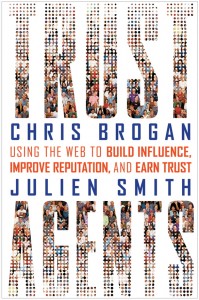 Written by Chris Brogan and Julien Smith, Trust Agents: Using the Web to Build Influence, Improve Reputation, and Earn Trust is for everybody, including folks who think that they have already achieved the status of being “trust agents,” and who believe they know all the ropes and tricks of the social media business. I say this from the start because a young entrepreneur was telling me that this book addresses people either looking for Trust Agents or hoping to become one. “Do you see yourself as a Trust Agent?” I asked. “Kind of,” he responded somewhat coquettishly, immediately mentioning that he had thousands of followers on Twitter for his company. He “had a reputation,” and he had “earned it.” As if any reputation were a “good” one by default (the internet version of “any publicity is good publicity”)! As if a “good” reputation at any given time entitled anybody or any company to be trusted in perpetuity. Madoff was a “Trust Agent” in his field, and remained so for a long time mainly because people are so scared at the idea of trusting people that they are even more scared at the idea of questioning the trust they have placed in them… All of this to say that this book addresses anybody: the perpetweeters who feel like inductees into the Web-pantheon — yet can be dismantled as easily as any statues – and, of course, those who wonder how to expand their influence.
Written by Chris Brogan and Julien Smith, Trust Agents: Using the Web to Build Influence, Improve Reputation, and Earn Trust is for everybody, including folks who think that they have already achieved the status of being “trust agents,” and who believe they know all the ropes and tricks of the social media business. I say this from the start because a young entrepreneur was telling me that this book addresses people either looking for Trust Agents or hoping to become one. “Do you see yourself as a Trust Agent?” I asked. “Kind of,” he responded somewhat coquettishly, immediately mentioning that he had thousands of followers on Twitter for his company. He “had a reputation,” and he had “earned it.” As if any reputation were a “good” one by default (the internet version of “any publicity is good publicity”)! As if a “good” reputation at any given time entitled anybody or any company to be trusted in perpetuity. Madoff was a “Trust Agent” in his field, and remained so for a long time mainly because people are so scared at the idea of trusting people that they are even more scared at the idea of questioning the trust they have placed in them… All of this to say that this book addresses anybody: the perpetweeters who feel like inductees into the Web-pantheon — yet can be dismantled as easily as any statues – and, of course, those who wonder how to expand their influence.
The book is structured around the six main features of a Trust Agent:
1. They make they own game. Nothing to do with ego packaging. They are the people who set new rules and provide a novel or interesting perspective on things.
2. They are “one of us.” The expression “social media” maybe somewhat redundant, except that the Web can also be the playing ground of antisocial nerds and weirdos. Trust Agents are people we can relate to and care about others.
3. They understand the principle of the lever – or the Archimedes effect (“Give me a place on which to stand, and I will move the earth”) and empower others.
4. They are marvel-ous connectors — they have the power of an “Agent Zero.” “No matter where they go, trust agents have a desire to connect good people together.” They are not mere networkers and are more like relationship facilitators.
5. They are human artists. On the Web, we are deprived on 93 percent of all the human signals (38 percent vocal tones and 55 percent body movement), which exposes anybody to a number of blunders. They understand the subtle aesthetics and the etiquette of communication.
6. They know how to “build an army.” You can’t do it alone. But how can you best convince thousands of ronin and lone rangers to join in and follow? The loyalty of people is first and foremost your loyalty, as a Trust Agent, to them. The Kmart incident (http://www.chrisbrogan.com/advertising-and-trust/) let the authors realize that “there are agreements, often implicit, between people and that these social contracts need to be clear and understood at all times.”
The chapter “Build an Army” ends with an interesting statement: “Most of the meat of the business isn’t in using these [social media] tools, but rather in how they are applied uniquely to your organization.” The how requires a new type of skill, and tellingly enough, the conclusion of the book starts with an interesting statement: “Business, it feels, is becoming an art,” the art of humanizing people that you may never see, and at looking at a random collection of people as real human beings emotionally connected by what the authors often call a “social contract.” Push marketers are doomed to belong to another age, and social media marketing, still kind of a sidekick in marketing organizations, will be the cornerstone of the next marketing age – one governed by a completely new understanding of the value of customer service.
I like this book for many reasons. It’s pragmatic and offers actionable advice to individuals and business leaders. I like the underlying assumption of a good-natured, transparence-driven popular sovereignty of digital natives that trust agents must respect to remain trust agents – and not turn into a body of traders controlling the social media business. I was interested by the fact that it is written by two authors who end up complementing each other as they express the complexity of a social media scene, the strange confluence of behaviors that we have caught from living on the Internet for the last 15 years, playing computer and video games (from the first SimCity to MMO games), reading American comic-books while still breathing in the real world.
 A little while ago, Julien Smith offered an interesting tweet: “if websites were people” with an image from http://imgur.com. Each individual may be all these personas at once — yes, building effective social marketing campaigns will require art and science.
A little while ago, Julien Smith offered an interesting tweet: “if websites were people” with an image from http://imgur.com. Each individual may be all these personas at once — yes, building effective social marketing campaigns will require art and science.
Marylene Delbourg-Delphis
For more information:
http://www.chrisbrogan.com
http://www.inoveryourhead.net
http://imgur.com is an image sharer created by Alan Schaaf (www.alanschaaf.com), a computer science at Ohio University.
Tags:Agent Zero·Alan Schaaf·Chris Brogan·Entrepreneurship·Internet Personas·Julien Smith·Leadership·Principle of the lever·Social Media and Customer Service·Social Media Marketing·Social Media Marketing Campaign·Trust Agent
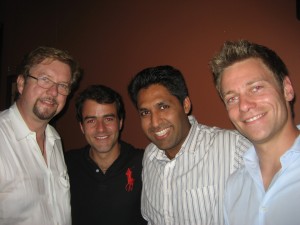 About 40 students of the INSEAD business school from both the Singapore and the Fontainebleau campuses spent the week in Silicon Valley and attended various presentations and lectures, all remarkably coordinated by Dominique Trempont (left on the picture with three students, Mauricio from Colombia, Fawad from Pakistan and Philipp from Germany). I already spoke about INSEAD a while ago in a conversation with Eric Benhamou. This week, I was able to take a closer look at the exceptional value of this 12-month intensive MBA program, as well as the quality of the human experience provided by this truly international business school. The students who chose the Silicon Valley program are a subset of the 2009 class (others selected different places). I was impressed by this group of brilliant and open-minded folks born in about 25 different countries — and I was ever more impressed to find out that not all of them intend to pursue a career in high-tech. I have no idea how the admission process at INSEAD works, yet it’s clear from the sample I saw that the school is very good at identifying authentically curious people, those who, as Mark Twain said, are able to “Sail away from the safe harbor. Catch the trade winds in [their] sails. Explore. Dream. Discover.”
About 40 students of the INSEAD business school from both the Singapore and the Fontainebleau campuses spent the week in Silicon Valley and attended various presentations and lectures, all remarkably coordinated by Dominique Trempont (left on the picture with three students, Mauricio from Colombia, Fawad from Pakistan and Philipp from Germany). I already spoke about INSEAD a while ago in a conversation with Eric Benhamou. This week, I was able to take a closer look at the exceptional value of this 12-month intensive MBA program, as well as the quality of the human experience provided by this truly international business school. The students who chose the Silicon Valley program are a subset of the 2009 class (others selected different places). I was impressed by this group of brilliant and open-minded folks born in about 25 different countries — and I was ever more impressed to find out that not all of them intend to pursue a career in high-tech. I have no idea how the admission process at INSEAD works, yet it’s clear from the sample I saw that the school is very good at identifying authentically curious people, those who, as Mark Twain said, are able to “Sail away from the safe harbor. Catch the trade winds in [their] sails. Explore. Dream. Discover.”
I was one of the speakers invited by Dominique Trempont during the week. The theme of my lecture was “Starting a company: Thrills and Agonies.”
You can establish a list of reasons of why startups fail, and come up with 5, 10, 15, or 20 causes of failures depending on the angle you take. In the end, only one may be deadly: when a startup creates a product that nobody wants. In this presentation, I focused more specifically on one important factor that can improve the chances of succeeding: the depth and breadth of an entrepreneur’s commitment to his/her project, and subsequently, his/her ability to draw people to his/her cause.
Here below is the slideshow that I used and a short summary of the themes I discussed for 90 minutes. Over the next few weeks, I may discuss some of these slides more extensively.
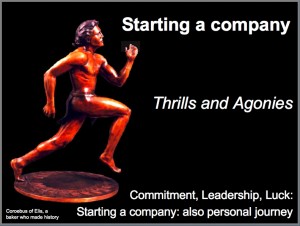 You may create a list of the do’s and don’ts. Yet, we all have to go through mistakes and agonies. Few are fatal by themselves. Remember that in ancient Greek “Agonia” is a mental struggle for victory and that “agein” means to lead! Agonies strengthen the determination to win, and this determination is based on the depth and breadth of your personal commitment. You need a little bit of luck. Sure, but you are able to manage on what you want to gamble and how you will gamble. In other words, you can build your luck.
You may create a list of the do’s and don’ts. Yet, we all have to go through mistakes and agonies. Few are fatal by themselves. Remember that in ancient Greek “Agonia” is a mental struggle for victory and that “agein” means to lead! Agonies strengthen the determination to win, and this determination is based on the depth and breadth of your personal commitment. You need a little bit of luck. Sure, but you are able to manage on what you want to gamble and how you will gamble. In other words, you can build your luck.
 Maybe you were born to be poet… But “oratores” – speakers are made, and so are entrepreneurs, who are first and foremost storytellers. If you cannot evangelize your product, this means that either you have no product to evangelize or that you are unwilling to carry the torch of your company. You may be shy today or wonder if you will ever be able to really make the jump. But the day you have the idea of a company, you have the stamina to defend and promote your idea. Even if you are awkward, your passion will come across.
Maybe you were born to be poet… But “oratores” – speakers are made, and so are entrepreneurs, who are first and foremost storytellers. If you cannot evangelize your product, this means that either you have no product to evangelize or that you are unwilling to carry the torch of your company. You may be shy today or wonder if you will ever be able to really make the jump. But the day you have the idea of a company, you have the stamina to defend and promote your idea. Even if you are awkward, your passion will come across.
 The strength of your bond with your project is a critical component of success and you often don’t know what you are capable of before you actually get into it. Your are more than you resume. Your “background” is not simply a resume – which is actually only a “foreground.” The real background of a person is the software that is running in the head and the heart of that person, is not being displayed but is operating. Or if you think of the “background” in painting, it is all the landscape, the objects or simply the light behind or around that person. This “background” says a lot about you, often silently. It says if you believe in what you do and how courageous you will be if needed.
The strength of your bond with your project is a critical component of success and you often don’t know what you are capable of before you actually get into it. Your are more than you resume. Your “background” is not simply a resume – which is actually only a “foreground.” The real background of a person is the software that is running in the head and the heart of that person, is not being displayed but is operating. Or if you think of the “background” in painting, it is all the landscape, the objects or simply the light behind or around that person. This “background” says a lot about you, often silently. It says if you believe in what you do and how courageous you will be if needed.
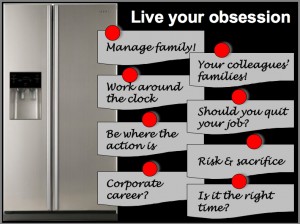 Entrepreneurs are dedicated to their project. In fact, their are obsessed by it. But they rarely live alone. So more often than not, they have to manage the risks and sacrifice associated to the fact of starting a company and they have to be aware that their goal may put some strain on their personal environment and family. So address all of this upfront. Also make sure that your colleagues also get their own family’s buy-in. A typical scenario that I have seen happen quite a few times: one of the founders promising his/her sweetheart that he/she wouldn’t on Saturdays or on Sundays or after hours or before a given hour. Fine… except for this: you’ll find bugs in your product when your most committed early adopters are ready to play with it, i.e. during weekends, at dawn or after hours. If your startup are not available to support them and eventually correct an obvious bug, how will you convince them to be committed to you if you are not unconditionally committed to them?
Entrepreneurs are dedicated to their project. In fact, their are obsessed by it. But they rarely live alone. So more often than not, they have to manage the risks and sacrifice associated to the fact of starting a company and they have to be aware that their goal may put some strain on their personal environment and family. So address all of this upfront. Also make sure that your colleagues also get their own family’s buy-in. A typical scenario that I have seen happen quite a few times: one of the founders promising his/her sweetheart that he/she wouldn’t on Saturdays or on Sundays or after hours or before a given hour. Fine… except for this: you’ll find bugs in your product when your most committed early adopters are ready to play with it, i.e. during weekends, at dawn or after hours. If your startup are not available to support them and eventually correct an obvious bug, how will you convince them to be committed to you if you are not unconditionally committed to them?
 You may decide to become an entrepreneur and then, look for a good domain to start a business in. That’s possible. You may choose a “promising” area with the blessing of the best strategic marketers and analysts of the world, but the lack of a real symbiotic relationship between your goal for your company and your personal reality may come back to bite you. Will you have the right instinct should something unforeseen happen? Will you be able to understand your most passionate early adopters? It’s so much easier to evangelize a product that you live and breathe! Later down the road, when the company is established, this close relationship is not quite as important (your customer base speaks for you).
You may decide to become an entrepreneur and then, look for a good domain to start a business in. That’s possible. You may choose a “promising” area with the blessing of the best strategic marketers and analysts of the world, but the lack of a real symbiotic relationship between your goal for your company and your personal reality may come back to bite you. Will you have the right instinct should something unforeseen happen? Will you be able to understand your most passionate early adopters? It’s so much easier to evangelize a product that you live and breathe! Later down the road, when the company is established, this close relationship is not quite as important (your customer base speaks for you).
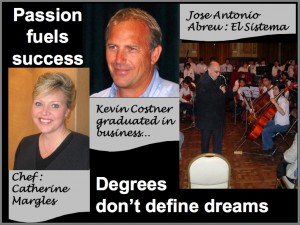 And your passion can be anything! Don’t feel obligated to choose a domain or a certain type of career just because you earned a business degree — it will be precious anyway. Don’t let people tell you “How come you invested money in an MBA [or whatever] to finally choose to do this! Or do not wrap yourself in some superiority complex. Degrees are not meant to curb dreams. Catherine Margles has an MBA from Kellogg and after 15 years in finance, she decided to pursue her dreams of cooking and writing. Look at the amazing life of José Antonio Abreu, an economist, who created the Foundation for the National Network of Youth and Children Orchestras of Venezuela – now El Sistema, arguably the most successful artistic organization in the world.
And your passion can be anything! Don’t feel obligated to choose a domain or a certain type of career just because you earned a business degree — it will be precious anyway. Don’t let people tell you “How come you invested money in an MBA [or whatever] to finally choose to do this! Or do not wrap yourself in some superiority complex. Degrees are not meant to curb dreams. Catherine Margles has an MBA from Kellogg and after 15 years in finance, she decided to pursue her dreams of cooking and writing. Look at the amazing life of José Antonio Abreu, an economist, who created the Foundation for the National Network of Youth and Children Orchestras of Venezuela – now El Sistema, arguably the most successful artistic organization in the world.
 Passion fuels another key factor for success: No matter how shy you may be, it gives you the desire to evangelize your idea, find co-founders, great early employees and build a network of like-minded individuals. The original team must be a group of contaminated people able to bounce back ideas. Eventually they may end up creating a product that is different from what was originally planned — and part along the way (this is the history of Blogger, which had started as PyraLabs and was supposed to be a web-based project and contact manager, and to-do list). Finding partners is a real viability test for your idea. If you can’t rally support for your project, why would you believe that you have a market?
Passion fuels another key factor for success: No matter how shy you may be, it gives you the desire to evangelize your idea, find co-founders, great early employees and build a network of like-minded individuals. The original team must be a group of contaminated people able to bounce back ideas. Eventually they may end up creating a product that is different from what was originally planned — and part along the way (this is the history of Blogger, which had started as PyraLabs and was supposed to be a web-based project and contact manager, and to-do list). Finding partners is a real viability test for your idea. If you can’t rally support for your project, why would you believe that you have a market?
 Another viability test is your ability to attract advisors, mentors and possibly angel investors — often entrepreneurs who have been involved in the field (or are simply interested in discovering a new domain and are willing to learn new things). In doing so, you rally the support of people who are outside your own circle or the circle of the people who are going to work with you. Their role is to help you, but also to challenge you. If you can’t get knowledgeable and committed advisors, see this as a warning sign. By the time you have enrolled co-founders and industry advisors, you have have a better idea of the value of your idea and if it is more than a marginal niche opportunity.
Another viability test is your ability to attract advisors, mentors and possibly angel investors — often entrepreneurs who have been involved in the field (or are simply interested in discovering a new domain and are willing to learn new things). In doing so, you rally the support of people who are outside your own circle or the circle of the people who are going to work with you. Their role is to help you, but also to challenge you. If you can’t get knowledgeable and committed advisors, see this as a warning sign. By the time you have enrolled co-founders and industry advisors, you have have a better idea of the value of your idea and if it is more than a marginal niche opportunity.
 Talk to potential customers as soon as possible to refine your concept, the capabilities of your product or the definition of your service – and, of course, find early adopters as soon as you come up with an alpha offering. Leverage your network or simply pick up your phone. Listen to their feedback. Be ready to make adjustments almost on the fly. Leadership is also the art of listening. You all know the Rogers’ curve. He was the son a farmer from Iowa who had been reluctant to adopt a new hybrid drought resistant seed corn and saw his crop wither during the 1936 drought. Rogers studied agriculture. He had planned to become a farmer himself — but ended up dedicating his career to innovation processes.
Talk to potential customers as soon as possible to refine your concept, the capabilities of your product or the definition of your service – and, of course, find early adopters as soon as you come up with an alpha offering. Leverage your network or simply pick up your phone. Listen to their feedback. Be ready to make adjustments almost on the fly. Leadership is also the art of listening. You all know the Rogers’ curve. He was the son a farmer from Iowa who had been reluctant to adopt a new hybrid drought resistant seed corn and saw his crop wither during the 1936 drought. Rogers studied agriculture. He had planned to become a farmer himself — but ended up dedicating his career to innovation processes.
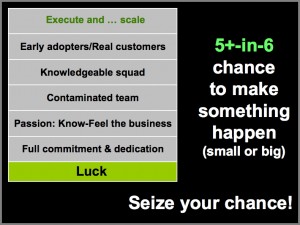 Here is a summary of the steps to get your startup off the ground and improve your chances of success. Each step helps you test the viability of your business idea. Each step obliges you to evangelize and sell. By the time you have real early adopters and customers, you know that you have something. Then, execute and scale (if allowed by the nature of the business). You are not quite a startup any longer. You are a “young company.” This is a different topic.
Here is a summary of the steps to get your startup off the ground and improve your chances of success. Each step helps you test the viability of your business idea. Each step obliges you to evangelize and sell. By the time you have real early adopters and customers, you know that you have something. Then, execute and scale (if allowed by the nature of the business). You are not quite a startup any longer. You are a “young company.” This is a different topic.
Marylene Delbourg-Delphis
For more information about DominiqueTrempont: http://en.wikipedia.org/wiki/Dominique_Trempont
Earlier post: http://delbourg-delphis.com/2009/01/eric-benhamous-course-at-insead-from-start-up-to-fortune-500
Tags:Agonia·Blogger·Catherine Margles·Dominique Trempont·El Sistema·Entrepreneurship·Entrepreneurship and Passion·Eric Benhamou·Evangelism·Everett Rogers·INSEAD·International Business School·José Antonio Abreu·Leadership·MBA program·Poetae nascuntur fiunt oratores·PyraLabs·startup·Success and Failures for Startups
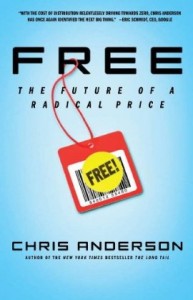 In case you haven’t yet read Free: The Future of a Radical Price, by Chris Anderson, simply do it. I will be short as the book has been extensively discussed even though it came out only one month ago.
In case you haven’t yet read Free: The Future of a Radical Price, by Chris Anderson, simply do it. I will be short as the book has been extensively discussed even though it came out only one month ago.
“With the cost of distribution relentlessly driving toward zero, Chris Anderson has once again identified the next big thing,” says Google’s CEO, Eric Schmidt on the book jacket. I don’t know if it is the “next big thing,” but Google being a money machine, it’s enough to assume that the notion of anything being “free” is relative to cultural and business practices, behavioral patterns and ideologies. It’s also relative to measuring instruments: the cost of bits can’t be measured using conventional standards and is as invisible to the naked eye as were atomic scale manipulations before scanning tunneling microscopy was made possible by Gerd Binning and Heinrich Rohrer’s invention in 1981. Yet, bits do have a high marketing and societal value, and according to Anderson, they are both the pillars and symbol of our entering into a free economy that is much larger than the visible world of dollars and cents. In a way, the Web economy is restaging some of the concepts of non-monetary economies that basically disappeared after the 18th century.
Although most of the variations of what “Free” means are familiar to most entrepreneurs, the book is an interesting read for two main reasons:
1) Educational: Lots of interesting historical considerations, anecdotes and references, even though the book is not intended to be a manual of economy. And if you are skeptical about the actual worth of radical pricing, the section “You get what you pay for,” will dispel most of your doubts — while, eventually, giving you the freedom of not being fully sold on the scalability of “Free,” or the power structures that are attached to what’s “Free.”
2) Practical: With the history of the meanings of “free,” the book also presents various freemium tactics. If the purpose is not to provide you with a solution for your particular problem and or to help you operationally, the book will, at least, free you from the idea of resorting to pricing models that are blatantly anachronistic as you try to build a sustainable business within a reasonable timeframe (don’t expect VCs to subsidize loose strategies!).
Marylene Delbourg-Delphis
PS — As a reminder, it’s never too late to read The Long Tail, if you haven’t: Long Tail, The, Revised and Updated Edition: Why the Future of Business is Selling Less of More
Tags:Chris Anderson·Entreneurship·Free: The Future of a Radical Price·Freemium·Pricing strategy·The Long Tail·Web economy
 A few days ago, I had lunch with Chris Shipley. I remember being impressed by her when Stewart Alsop introduced her to me when she became the Executive Producer of DEMO. Very few women were likely to hold such a highly visible position in the high-tech industry in 1996 (and there may not be too many today either). Thirteen years later, after watching thousands of products, helping hundreds of companies, she is really the same person: soft-spoken, matter-of-fact, quietly observant of everything around her and gently humorous. However secure she may be in her judgment, she remains incredibly humble. Of course, others are more than happy to speak up for her. As Marc Benioff told me, “Chris has been a provocateur and industry visionary that has driven all of us forward in important new ways.”
A few days ago, I had lunch with Chris Shipley. I remember being impressed by her when Stewart Alsop introduced her to me when she became the Executive Producer of DEMO. Very few women were likely to hold such a highly visible position in the high-tech industry in 1996 (and there may not be too many today either). Thirteen years later, after watching thousands of products, helping hundreds of companies, she is really the same person: soft-spoken, matter-of-fact, quietly observant of everything around her and gently humorous. However secure she may be in her judgment, she remains incredibly humble. Of course, others are more than happy to speak up for her. As Marc Benioff told me, “Chris has been a provocateur and industry visionary that has driven all of us forward in important new ways.”
DEMO: Watching the entire High-Tech market… One of the most striking characteristics of Chris is her rare ability to master multiple areas of the high-tech industry and select companies for DEMO that represent a large range of technologies and applications and address multiple market sectors. While most analysts and pundits tend to focus on one main trend or try to seize “the” next big thing, Chris is more interested in finding the patterns that, at a given time, build up the overall industry landscape in its actual diversity, all the more so as most users have more than one need at a time. Whether she looks (or looked) at salesforce.com, VMware, Xfire, Glam, WebEx, Blurb, Six Apart, at an infrastructure play or a Web 2.0 application, she wants to find the products that will make a difference in the life of people, be they John Doe or IT folks. Alsop, “who always likes to take credit for hiring Chris to run DEMO,” as he told me, remembers that what went into his decision to select her (“one of the best decisions I ever made, obviously),” was primarily this: “Reading what Chris wrote about products, I always had the feeling that she had an intuitive sense about products and how customers would react to them. And that’s the critical element in putting DEMO together every year.”
The reality is that in 1996 when she started, there were significantly fewer products to look at, and fewer trends to follow, and one can only marvel at her capability to work around the clock, decipher the meaning and the value of some products despite the dismal presentations entrepreneurs sometimes make, and figure out potentially emerging trends through eventually half-baked concepts — while keeping away from fads or ephemeral flashy ideas. Having a nose for a few winning companies here and there is one thing that deserves lots of kudos. Exhibiting such prolonged leadership and perceptiveness as Chris has for so long at the helm of one of the most famous high-tech conferences in the world and whose choices are scrutinized and commented by hundreds of competent observers twice a year is a whole different game. Only a handful of extraordinarily insightful VCs have delivered a similar continuous performance.
“All-around startup enthusiast...” That’s how Chris describes herself. Chris will hand the DEMO baton over to Matt Marshall of VentureBeat in the Fall, and focus exclusively on her own startup, the Guidewire Group, that she co-founded with Mike Sigal in 2004. “DEMO is a great platform. Lots of companies. Lots of ideas,” she says. “Yet, DEMO only allows a certain level of engagement. With The Guidewire Group, I can go much further. I love working with young companies because with the right people and a right idea in an early market, it’s all discovery and invention and that’s intellectually very interesting. You can have a bigger impact.”
Chris definitely knows how to speak to entrepreneurs — mostly because her leadership starts with the ability to listen. While it is easy when you have such breadth and wealth of experience to become somewhat overwhelming, Chris is especially gifted in guiding them, starting from their own perspective to smoothly steer them towards a better assessment of where they are at and what they can do. I especially liked her speech at the closing of a recent French Tech Tour where she was inviting the audience to the Guidewire Group’s Innovate!Europe Showcase. While she could have dogmatically listed the Do’s and Dont’s when venturing to the United States, she presented a well thought-out slideshow of the Christopher Columbus enterprise. Yes, “It takes time,” she reminded the audience, “to become an ‘overnight success'”, but you will eventually manage it. “Isabel rejected Columbus three times before finally backing his venture.”
 Originally from the East Coast, Chris is a Silicon Valley guru. Although the Valley is unambiguously the hotbed of entrepreneurship (with 52% of start-up companies created by immigrant founders), Chris doesn’t wait for all the entrepreneurs who might benefit from coming over here to just show up with their suitcases and their dreams. They need to have a better idea of what to expect — or simply be able to remotely benefit from the accumulated knowledge of the Valley’s unique ecosystem. So, she travels and reaches out for them in their own countries: “The Valley doesn’t have a lock on innovation,” she writes in her DEMOletter (http://www.demo.com/community/?q=node/285976). “Smart ideas are inspired by a range of experiences.” The Guidewire Group’s Going Global workshops for Innovate!Europe (http://www.innovate-events.com) are extremely successful. At the time of our lunch, she was getting ready to fly to Taipei. Chris is definitely open to the “rest of the world,” first because she is extremely cultivated, and secondly because she is curious. Incidentally, she seems to be an habitué of Dehillerin, Paris’s oldest and probably most famous cookware shop.
Originally from the East Coast, Chris is a Silicon Valley guru. Although the Valley is unambiguously the hotbed of entrepreneurship (with 52% of start-up companies created by immigrant founders), Chris doesn’t wait for all the entrepreneurs who might benefit from coming over here to just show up with their suitcases and their dreams. They need to have a better idea of what to expect — or simply be able to remotely benefit from the accumulated knowledge of the Valley’s unique ecosystem. So, she travels and reaches out for them in their own countries: “The Valley doesn’t have a lock on innovation,” she writes in her DEMOletter (http://www.demo.com/community/?q=node/285976). “Smart ideas are inspired by a range of experiences.” The Guidewire Group’s Going Global workshops for Innovate!Europe (http://www.innovate-events.com) are extremely successful. At the time of our lunch, she was getting ready to fly to Taipei. Chris is definitely open to the “rest of the world,” first because she is extremely cultivated, and secondly because she is curious. Incidentally, she seems to be an habitué of Dehillerin, Paris’s oldest and probably most famous cookware shop.
Chris is one of the most successful women in the high-tech industry, although “fewer than 10 percent of venture-based technology companies have a woman on the founding team.” I like the fact that this statistic doesn’t lead her to simply declare (http://www.demo.com/community/?q=node/20448) that it is because “venture is a male-dominated business dismissive, if not outright hostile, toward women […] Women-founded startups are often, in my experience,” she states, “a different breed and have a different funding need. In fact, many young women benefit more from mentor capital than venture capital, at least in the earliest days of their young companies’ lives.” One thing is certain, though: “I do want to encourage young women to entrepreneurship of any type,” says Chris — who had been at the board of the Forum for Women Entrepreneurs and Executives (http://www.fweande.org) for almost ten years!
Marylene Delbourg-Delphis
More about Chris Shipley:
http://www.cshipley.com/
http://www.demo.com
http://www.guidewiregroup.com
Tags:Blurb·Chris Shipley·Dehillerin·DEMOletter·French Tech Tour·Glam·Guidewire Group·High-Tech Entrepreneur·Innovate!Europe·Leadership·Marc Benioff·Matt Marshall·Mike Sigal·Salesforce.com·Silicon Valley Ecosystem·Silicon Valley guru·Six Apart·startup·Stewart Alsop·VentureBeat·VMware·WebEx·Women in high-tech·Women-founded startups·Xfire
 It is simply a great pleasure to step into a class of some eighty highly motivated students: when I asked who planned to start a company one day, at least half of them raised their hands!
It is simply a great pleasure to step into a class of some eighty highly motivated students: when I asked who planned to start a company one day, at least half of them raised their hands! Where do you start? Read good books. The Art of the Start and Reality Check by Guy Kawasaki are the best ones. I also like Sramana Mitra’s series, Entrepreneur Journeys, because they provide portraits of entrepreneurs. Then, create your own story. Feel it. Live it. Discuss your project with those who are the closest to you, generally your family – because more often than not, they are the most likely to give you a frank opinion and support your efforts. If you want to create a five-wheel car, they won’t feel obligated to tell you politely that it’s “interesting.” Although it is possible that what you want to do is well above their head or their domain of interest or expertise, they will ask you the first hard questions (What’s the use of it? How come nobody had this idea before? Are you sure that people want this kind of stuff?). You have to recount a compelling story on why you, of all people, would be able to do something that nobody does or cannot do as well as you think you can.
Where do you start? Read good books. The Art of the Start and Reality Check by Guy Kawasaki are the best ones. I also like Sramana Mitra’s series, Entrepreneur Journeys, because they provide portraits of entrepreneurs. Then, create your own story. Feel it. Live it. Discuss your project with those who are the closest to you, generally your family – because more often than not, they are the most likely to give you a frank opinion and support your efforts. If you want to create a five-wheel car, they won’t feel obligated to tell you politely that it’s “interesting.” Although it is possible that what you want to do is well above their head or their domain of interest or expertise, they will ask you the first hard questions (What’s the use of it? How come nobody had this idea before? Are you sure that people want this kind of stuff?). You have to recount a compelling story on why you, of all people, would be able to do something that nobody does or cannot do as well as you think you can. The skepticism of people you trust may very well infuriate you, but will force you to hone your arguments – and if the topic is difficult, to express your hyper-sophisticated system in layman terms. This is not silly at all. Think of it this way: If you go public one day, you will have to offer a plain story to thousands of John Doe’s so that they buy your stocks. Incidentally, it’s also only if they have an idea of what you are talking about that your family will bear with the fact that you will work around the clock, take no vacation, live on a shoestring, etc.! One of the students, Tia, wondered if becoming an entrepreneur was putting a strain on personal relationships. To which I responded that it often does and that entrepreneurs have to be aware of it. To make good, though, I also added that personal relationships that collapse because of this, would most likely collapse anyway!
The skepticism of people you trust may very well infuriate you, but will force you to hone your arguments – and if the topic is difficult, to express your hyper-sophisticated system in layman terms. This is not silly at all. Think of it this way: If you go public one day, you will have to offer a plain story to thousands of John Doe’s so that they buy your stocks. Incidentally, it’s also only if they have an idea of what you are talking about that your family will bear with the fact that you will work around the clock, take no vacation, live on a shoestring, etc.! One of the students, Tia, wondered if becoming an entrepreneur was putting a strain on personal relationships. To which I responded that it often does and that entrepreneurs have to be aware of it. To make good, though, I also added that personal relationships that collapse because of this, would most likely collapse anyway!























